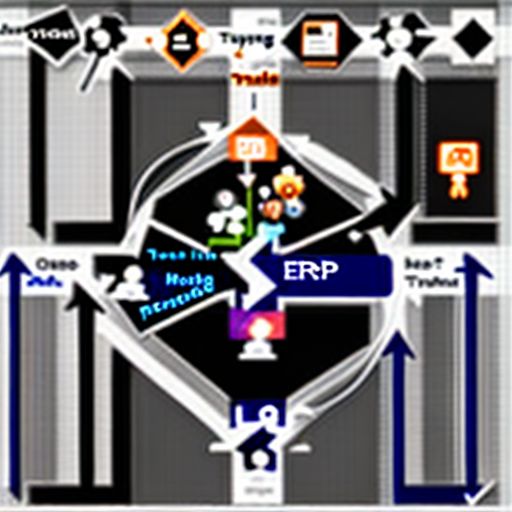Imagine this: your business is growing, but your current software systems are struggling to keep up. Data is siloed, processes are manual, and reporting is a nightmare. Sound familiar? This is where an Enterprise Resource Planning (ERP) system comes in, promising to streamline operations and unlock growth. However, implementing an ERP system is a complex undertaking, and understanding the Erp Implementation Life Cycle is crucial for success.
What is the Erp Implementation Life Cycle?
The ERP implementation life cycle is a structured approach to deploying an ERP system within an organization. It encompasses all the stages, from the initial planning phase to the ongoing support and maintenance after the system goes live. This cyclical process ensures a smooth transition and maximizes the chances of achieving the desired ROI.
Why is the Erp Implementation Life Cycle Important?
A well-defined ERP implementation life cycle is paramount to success. Here’s why:
- Reduces Risk: A structured approach mitigates risks associated with cost overruns, implementation delays, and user adoption challenges.
- Improves Communication: A clear roadmap keeps all stakeholders informed and aligned throughout the project.
- Enhances Efficiency: Defined processes and responsibilities streamline activities, optimizing time and resources.
- Ensures Scalability: The lifecycle framework allows for adjustments and scalability as the business grows and evolves.
erp.backinhtravel.com/wp-content/uploads/2024/07/erp-implementation-lifecycle-669a43.jpg" alt="ERP Implementation Life Cycle Diagram" width="512" height="512">ERP Implementation Life Cycle Diagram
The Stages of the Erp Implementation Life Cycle
While the specific stages may vary slightly depending on the methodology and project scope, a typical ERP implementation life cycle includes the following phases:
1. Planning and Analysis
- Define Business Needs: Clearly identify the pain points, challenges, and goals the ERP system aims to address.
- Assemble a Team: Establish a dedicated project team with representatives from all impacted departments.
- Determine Budget and Timeline: Estimate the total cost of ownership and develop a realistic implementation timeline.
- Select the Right ERP System: Evaluate different ERP vendors and solutions based on your specific requirements.
2. Design
- Business Process Mapping: Document and analyze existing business processes to identify areas for improvement and automation.
- System Configuration: Customize the ERP software to align with the organization’s unique workflows and data requirements.
- Data Migration Planning: Develop a strategy for migrating existing data into the new ERP system accurately and efficiently.
- User Interface (UI) Design: Create user-friendly interfaces that are intuitive and tailored to different user roles.
3. Development
- System Build and Customization: Developers customize the ERP software based on the design specifications.
- Integration Development: Connect the ERP system with existing applications and data sources, if required.
- Report and Dashboard Creation: Develop reports and dashboards to provide insights into key business metrics.
4. Testing
- Unit Testing: Validate individual components of the ERP system to ensure they function correctly.
- Integration Testing: Test the interaction between different modules within the ERP system and with external systems.
- User Acceptance Testing (UAT): Allow end-users to test the system in a real-world environment and provide feedback.
5. Deployment
- Data Migration: Transfer cleansed and validated data from legacy systems to the new ERP system.
- System Go-Live: Launch the ERP system in phases or all at once, depending on the chosen strategy.
- User Training: Provide comprehensive training to end-users on how to use the new ERP system effectively.
6. Support and Maintenance
- Ongoing Support: Provide technical assistance to users and address any post-implementation issues.
- System Monitoring: Regularly monitor the ERP system’s performance and identify areas for optimization.
- Software Updates and Upgrades: Implement software updates and upgrades to enhance functionality and security.
Common Questions About ERP Implementation
How long does an ERP implementation take?
The duration of an ERP implementation can vary widely depending on factors such as the size and complexity of the organization, the scope of the project, the availability of resources, and the chosen implementation approach. On average, implementations can range from a few months to over a year.
What are some common ERP implementation challenges?
- Resistance to change: Employees may be resistant to adopting new processes and systems.
- Data migration issues: Inaccurate or incomplete data migration can lead to system errors and reporting problems.
- Lack of user training: Inadequate user training can result in low adoption rates and reduced productivity.
- Integration complexities: Integrating the ERP system with legacy systems can pose technical challenges.
Conclusion
Implementing an ERP system is a significant investment that requires careful planning, execution, and ongoing support. By understanding and following the ERP implementation life cycle, organizations can increase their chances of success, mitigate risks, and realize the full potential of their ERP investment. Remember, a successful ERP implementation is an ongoing journey, not a destination, requiring continuous improvement and adaptation to evolving business needs.
